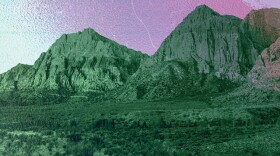Once dedicated to destruction, the former Nevada Test Site is now a boon to preservation
The words “Nevada Test Site” conjure images of a postnuclear wasteland, barren and pockmarked by the testing of weapons that represent the pinnacle of human destructive power. But I was recently given a once-in-a-lifetime chance to visit what is now called the Nevada National Security Site (NNSS), and I saw it in a different light: as one of America’s last untrammeled lands, inadvertently protected from humans for 60 years.
“Only about 10 percent of NNSS has been used for nuclear testing,” public involvement officer Dona Merritt told me. “That leaves well over a thousand square miles of essentially pristine desert.” I needed to see it for myself. A tour was arranged.
We entered the NNSS on the 22nd anniversary of “Divider,” the site’s final blast. The base’s Cold War motivations were painfully obvious — buildings were made of poured concrete or cinder blocks, and every angle was a right angle. As we drove further, we passed famous landmarks from its nuclear past: News Nob, Frenchman Flat, Sedan Crater. They seemed big, but they are a tiny fraction of the base.
Our first official stop was at the Beatley Plots to check out some creosote. Biological research being done at the Test Site is critical for our understanding of the natural world. As scientist Kathryn Knapp explained, “We can truly understand the different patterns, how it’s changing over time. And not because of human impact.”
But before we could traipse across the land, Richard Arnold, a Southern Paiute, gathered us into a circle and said a prayer in his native tongue. He asked the earth to shelter us as we wandered its expanse. Arnold is part of an NNSS initiative to embrace the area’s natural and cultural history. To that end, we were also joined by Linda Cohn, federal cultural-resources project manager, and Dr. Colleen Beck, a research professor and archaeologist with the Desert Research Institute.
At a site called Wunjiakuda — named for an enormous white rock that stands alone in a mountain valley; “wunjiakuda” roughly translates to “a thing that sticks out” — Arnold told stories of his ancestors, and of traditions that have mostly died out: vast rabbit hunts in valleys that are now part of the NNSS, annual tribal celebrations, weddings. Some of Arnold’s ancestors had been married in the valley in which we stood. He showed me where his grandfather carved his name into the towering white monolith. You could call it vandalism, but time has made it an artifact. Air Force pilots, in their turn, peppered Wunjiakuda with bullets, some still in their holes, now antiques.
As we stopped for lunch, a family of wild horses ambled in and out of view on a nearby hillside. Beck leaned over and picked up a piece of knapped obsidian, a leftover shard from an ancient toolmaker — thousand-year-old trash, just lying on the ground. In my decades of hiking in Southern Nevada, I’ve only seen a couple such artifacts. Within a minute I had found one myself; within a half-hour, I had found four more. Contrast that with Red Rock, which is so much richer in resources and human history; there, such treasures have departed in the pockets of hikers and amateur collectors. The fact that these artifacts can be lost to history so casually is a striking reminder of the importance of preserving NNSS.
We headed for the highest point in the Test Site, DOE Point. From this vantage, it was possible to see into Area 51, or, as Merritt is required to call it, “a neighboring military base.” Sadly, there wasn’t much to see. Just some distant buildings on a dry lakebed. But the vista was amazing all the same, and was made more special by the fact that so few people have stood where I stood.
So few white people, anyway. Richard Arnold reminded me that generations of Indians had roamed these hills. Several years ago, Beck was surveying a site near Wunjiakuda when she noticed a shovel in the branches of a tree. She found other artifacts hidden in trees. “As an archaeologist, I’ve spent my whole career looking down,” Beck explained. “Once I started looking up,” another world of discovery was revealed. Because the Southern Paiutes would spend half the year away from their valuable tools, the trees served as a secure cache, protecting them from nature’s destructive forces. When Beck published her findings, it prompted other archaeologists around the world to resurvey their sites.
When the Nevada Test Site was founded in 1951, its barren landscape was set aside so it could bear witness to mankind’s destructive ability. Sixty years later, human priorities have shifted enough that, while NNSS still protects our nuclear arsenal, it also protects one of America’s last untouched places.








